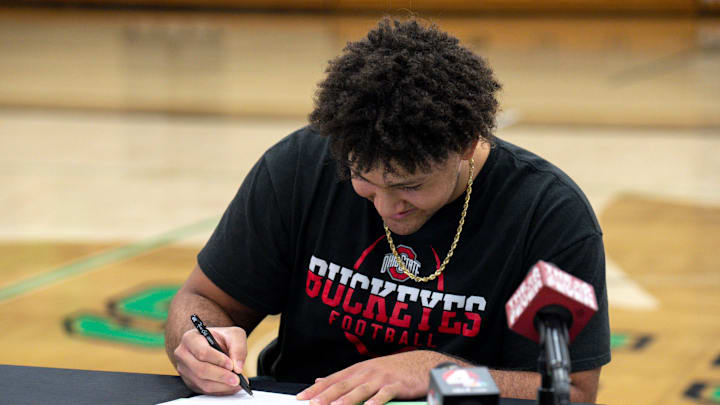In a groundbreaking decision, the NCAA eliminated the National Letter of Intent (NLI), a pivotal part of college sports recruiting for nearly six decades. This move marks a fundamental shift in how student-athletes commit to universities and comes in the wake of ongoing changes in collegiate athletics, such as the advent of name, image, and likeness (NIL) deals and the upcoming introduction of revenue sharing. For Ohio State football—a powerhouse in both recruiting and NIL—the effects of this decision are particularly significant.
NCAA’s seismic shift
The NCAA Division I Council approved the decision to abolish the NLI as part of a broader effort to modernize collegiate sports. According to Pete Nakos of On3, this change is directly tied to the "House v. NCAA" settlement, which could allow schools to pay athletes more than $20 million annually through revenue-sharing agreements starting in 2025.
Given this new financial landscape, the traditional NLI—an agreement between a student-athlete and a university that bound them to attend that institution for one year—was no longer feasible. Instead, recruits will now sign financial aid agreements and revenue-sharing contracts.
Historically, the NLI was the document recruits signed to solidify their commitment to a university. Once signed, recruits were bound to their chosen school for at least one year. With the NLI gone, the recruiting landscape is set to be transformed. According to Nakos, while the NLI is dead, written financial agreements will continue to exist, marking a new era for college sports.
Impacts on Ohio State football: A recruiting giant
Ohio State football, led by Ryan Day, is already one of the most successful recruiting programs in the nation. In fact, the Buckeyes boast the number one 2025 recruiting class, according to 247 Sports, as well as the top NIL collective in college athletics, per On3’s Pete Nakos. With the abolishment of the NLI, Ohio State’s position in the recruiting world could actually strengthen.
First, the Buckeyes' elite NIL infrastructure will play an even more critical role in attracting top talent. As NIL deals become more embedded in the recruiting process, Ohio State’s ability to offer substantial financial benefits through its NIL collective will be a game-changer.
Top recruits will look closely at how well a university can support them financially, especially as revenue-sharing begins. With Ohio State’s collective being the best in the nation, the program has a clear advantage in this new era of college athletics.
Moreover, the absence of the NLI may increase the flexibility and autonomy of athletes, but it could also solidify relationships between players and schools that excel in NIL and revenue-sharing agreements. Ohio State is already a destination for high-level recruits, and the strength of its NIL program can ensure that recruits are more likely to stay committed through financial aid agreements, even without the binding power of the NLI.
Financial aid and revenue sharing: The new reality
The new landscape of college football recruiting will center on financial aid agreements and revenue-sharing contracts. Athletes will no longer be signing the NLI but will instead commit through financial packages offered by schools. This new model will undoubtedly include NIL agreements, allowing student-athletes to benefit financially from their likeness and participation in sports.
In this context, Ohio State’s commitment to building a strong NIL program is crucial. With recruits signing financial aid agreements, the details of those contracts—particularly regarding NIL opportunities and potential revenue-sharing—will be central to their decision-making.
Ohio State’s existing infrastructure puts it in a favorable position to attract and retain top recruits. As Nakos notes, revenue-sharing is set to roll out with the 2025-26 academic year, meaning the next few recruiting cycles will be critical for programs like Ohio State to establish long-term relationships with athletes.
What’s next for college football recruiting?
While Ohio State and other top programs are well-positioned to navigate the transition, the next few years will bring uncertainty to the recruiting process across college football. December 4, 2024, will still mark an early signing day for football, but it will no longer revolve around the NLI.
Instead, the focus will shift to the new financial agreements that bind recruits to their schools. These agreements will likely include stipulations about NIL earnings, scholarship terms, and revenue-sharing details, further professionalizing college sports.
Ohio State’s dominance in NIL and recruiting makes it a leader in adapting to these changes. The Buckeyes' recruiting power, paired with a robust NIL collective, means the program can thrive in a future where financial aid agreements and revenue-sharing replace the NLI.
As one of the nation’s premier programs, Ohio State is poised to remain at the top of college football’s recruiting hierarchy, even as the sport undergoes its most significant transformation in decades.
In summary, the NCAA’s elimination of the National Letter of Intent is a historic moment for college sports. For Ohio State football, this change presents an opportunity to leverage its leading NIL collective and recruiting prowess to continue attracting the nation’s top talent. With a new focus on financial agreements and revenue sharing; the Buckeyes are well-equipped to navigate the future of college football recruiting.
